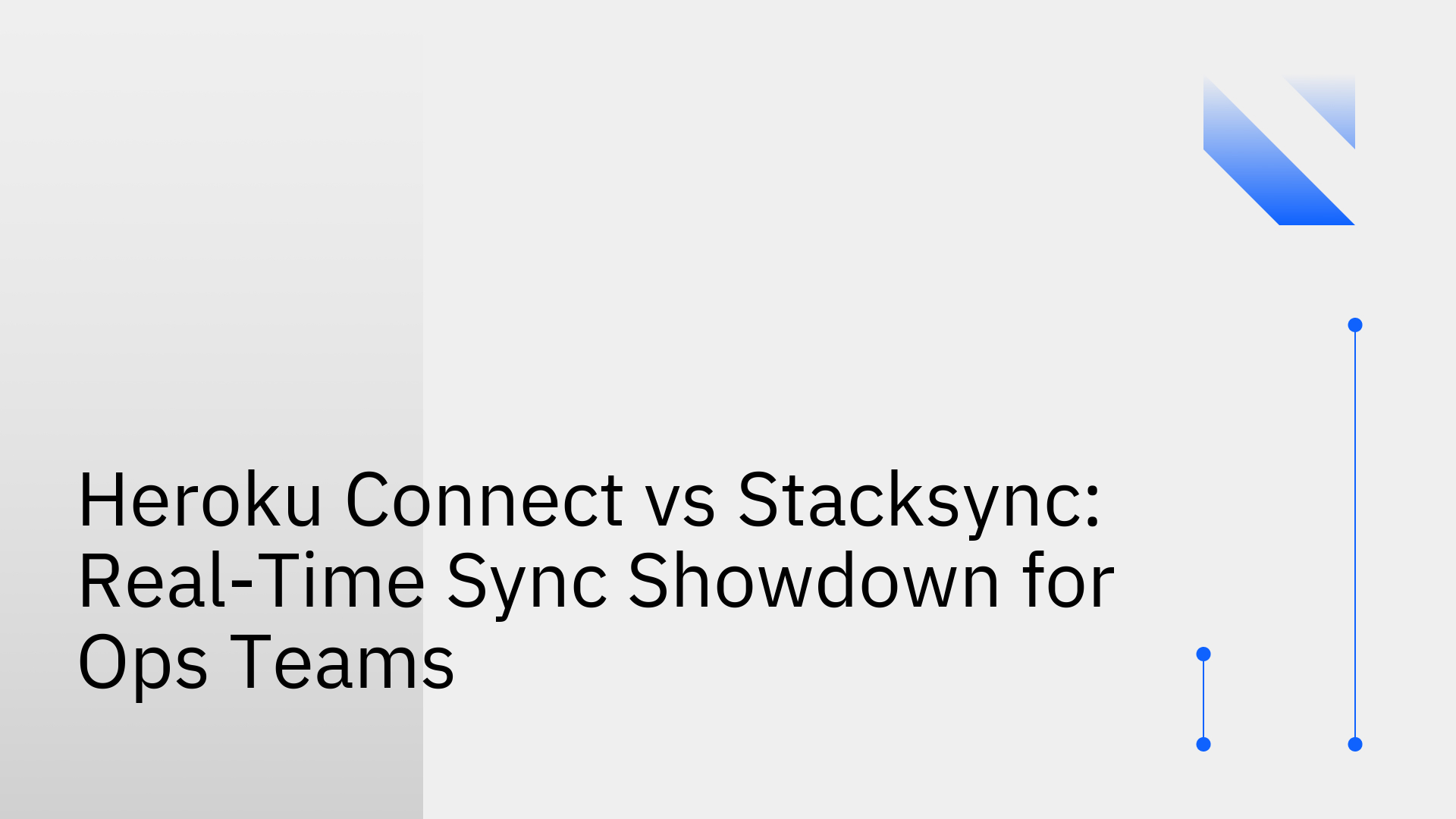
For modern operations, engineering, and RevOps teams, maintaining a single source of truth is not just a goal; it's a requirement for powering mission-critical applications and driving business velocity. Real-time data synchronization is the backbone of this strategy.
This brings a critical challenge: choosing the right tool. Do you opt for an established, ecosystem-specific service like Heroku Connect, or a modern, purpose-built platform like Stacksync? This article provides a direct comparison of Heroku Connect and Stacksync, evaluating key criteria like speed, connectivity, scalability, and cost to help your team make an informed decision.
Heroku Connect is a data synchronization service that creates a connection between a Salesforce organization and a Heroku Postgres database [7]. Its primary function is to enable developers to interact with Salesforce data directly within their Heroku applications using standard SQL, simplifying development for apps built on the Heroku platform.
While Heroku Connect supports bi-directional sync, its architecture is fundamentally batch-based. Updates are processed through a polling mechanism, which typically has a minimum interval of 10 minutes. This latency means it's not a true real-time solution. The most significant limitation, however, is its nature as a point-to-point solution designed exclusively for the Salesforce and Heroku Postgres ecosystem. For teams needing to integrate a wider array of tools, Heroku Connect falls short. Furthermore, its pricing, which is often tied to the number of synced rows, can escalate quickly, creating significant and often unpredictable budget challenges [2].
Stacksync is a modern data sync and workflow automation platform engineered for true real-time, bi-directional data movement. Unlike single-ecosystem tools, Stacksync is designed to connect a wide variety of systems, including CRMs like HubSpot and Pipedrive, ERPs such as NetSuite, and a vast range of databases like MySQL and Snowflake. This makes it one of the leading Heroku Connect and Fivetran vs Stacksync Real-Time Sync Platform for Mid-Market choices.
For ops teams, Stacksync’s key differentiators deliver tangible operational advantages:
These Stacksync Features for Real-Time Bi-Directional Data Sync Efficiency are designed to empower technical teams, not burden them.
To better compare Heroku Connect and Stacksync, here is a breakdown of their core functionalities.
Heroku Connect: Relies on batch-based synchronization, polling for changes at a minimum frequency of 10 minutes [8]. While it offers bi-directional capabilities, the delay and batch processing can lead to data conflicts that are complex to untangle.
Stacksync: Delivers true real-time, event-driven synchronization with changes propagating in milliseconds. Its architecture is natively designed for reliable two-way sync, which is a core advantage of Heroku Connect vs. Purpose-Built Solutions: Choosing the Right CRM Sync Platform. This ensures data consistency is maintained across all connected systems without manual oversight.
Heroku Connect: Functions as a point-to-point solution, tightly locked into the Salesforce and Heroku Postgres ecosystem. It is not designed for integrating with other databases, ERPs, or modern SaaS applications, severely limiting its utility in a diverse tech stack.
Stacksync: is a platform-agnostic solution that offers a growing library of over 200 connectors. This allows organizations to build complex, multi-point integrations and automate workflows across their entire technology stack, making it one of the premier Stacksync vs Workato and Heroku Connect Alternatives for Real-Time Data Sync.
Heroku Connect: Error resolution is often a manual and time-consuming process that requires digging through logs. The platform is susceptible to "silent failures," where sync issues can go unnoticed for extended periods, leading to data integrity problems.
Stacksync: Provides a proactive issue management dashboard. The Stacksync Platform offers real-time alerts via Slack or email and empowers ops teams to retry or revert failed syncs with a single click. This drastically reduces maintenance time and guarantees data reliability.
Heroku Connect: Pricing is primarily based on the number of rows synced. This model can become prohibitively expensive as data volumes grow, leading to unpredictable costs that can be a major budget drain [3].
Stacksync: Offers more predictable and cost-effective pricing. By focusing on value and features rather than just penalizing data volume, Stacksync reduces the hidden costs associated with engineering maintenance, troubleshooting, and operational downtime. You can learn more by reading a Demystifying Pricing Models: A Comparative Analysis of Stacksync, Heroku Connect, and Workato.
Making the right choice depends entirely on your operational needs and technical ecosystem.
Choose Heroku Connect if: Your organization is deeply committed to the Heroku and Salesforce ecosystem, your only use case is syncing Salesforce data to a Heroku Postgres database, and near-real-time performance (i.e., delays of 10 minutes or more) is acceptable for your applications.
Choose Stacksync if: You require true real-time, bi-directional sync for mission-critical operations, need to integrate multiple systems beyond Salesforce, demand robust error handling to ensure data reliability, and are looking for a scalable and more cost-effective Heroku Connect alternative.
Ready to see the difference a real-time sync platform can make? Start your 14-day free trial with Stacksync and experience the power of effortless data synchronization.